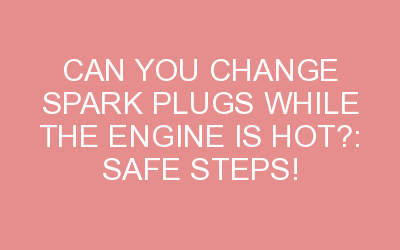It is not recommended to change spark plugs while the engine is hot. Allow the engine to cool down to avoid the risk of burns or damage.
Replacing spark plugs is a critical maintenance task for ensuring your vehicle’s engine runs smoothly and efficiently. Undertaking this task when the engine is hot can lead to a host of problems, including the risk of personal injury from burns or stripping the threads due to components expanding from the heat.
For optimal safety and performance, allow your vehicle’s engine to cool before attempting to change the spark plugs. This will ensure a safe working environment and protect the integrity of your engine components.
Always consult your vehicle’s manual for specific guidelines and allow your engine to reach a safe temperature, which usually means waiting at least 30 minutes after running your vehicle.
Understanding Spark Plug Replacement
Spark plug replacement is a crucial maintenance task that ensures the smooth operation of an engine. These small components play a vital role in the engine’s ignition system, and their condition can significantly affect your vehicle’s performance and efficiency.
Understanding when and how to replace spark plugs is essential for any driver looking to maintain their vehicle in top condition, including knowledge about the engine’s temperature during replacement.
Importance Of Spark Plugs In Engine Functionality
Spark plugs are the heart of an engine’s ignition system. They are responsible for igniting the air-fuel mixture within the combustion chamber. This ignition is what powers the engine, making the role of spark plugs critical for engine functionality. A well-functioning spark plug ensures:
- Efficient combustion process: leading to better fuel economy.
- Smooth engine operation: minimizing misfires and rough idling.
- Reduced emissions: by encouraging complete combustion, thus cutting down on harmful exhaust.
Performing a spark plug replacement involves removing the coil that sits atop the spark plug, unscrewing the old plug, checking the proper gap for the new plug, and screwing in the replacement carefully to avoid cross-threading.
Typically, replacing spark plugs should be done when the engine is cool to prevent damage to the engine block and threads of the spark plug hole.
Signs Of A Faulty Spark Plug
It’s vital to acknowledge the signs that a spark plug may be failing. A faulty spark plug can cause several symptoms, including:
| Symptom | Possible Cause |
| Engine misfire | An unreliable spark can cause inconsistencies in the combustion process |
| Hard to start engine | Problems with the ignition system, possibly related to spark plug issues |
| Increased fuel consumption | Poor combustion efficiency due to a compromised spark plug |
| Reduced acceleration | Insufficient spark can fail to ignite the fuel mixture adequately, leading to poor performance |
These indicators suggest that a spark plug could be deteriorating. In such a scenario, a timely inspection and replacement, if necessary, can avoid further damage to the engine.
While some drivers may attempt to perform this task with a hot engine, seasoned professionals advise against it due to the dangers of thermal expansion affecting component fit and the risk of burns.
Safety Precautions For Hot Engine Maintenance
Maintaining your car’s engine is an essential aspect of ensuring longevity and performance. However, conducting any maintenance on a hot engine can come with its own set of risks, especially when dealing with critical components like spark plugs.
Before you decide to perform such a task, it’s vital to observe stringent safety precautions to avoid injuries and engine damage.
Risks Of Changing Spark Plugs On A Hot Engine
Attempting to change spark plugs while the engine is hot poses several risks:
- The chance of burns is significantly increased as the engine components are too hot to touch.
- Metal expands when hot, so removing spark plugs from a hot engine can lead to stripped threads or damage to the cylinder head.
- The risk of over-tightening or cross-threading the spark plugs is higher which could lead to costly repairs.
- Hot engines can cause combustion residues to harden around the spark plug, making them more difficult to remove without damage.
It is always best to wait until the engine is cold before attempting to change the spark plugs. A cool engine not only minimizes the risk of burns but also ensures that the components have contracted to their normal size, reducing the chance of thread damage.
Personal Protective Equipment (ppe) Requirements
If you must handle a hot engine, it is paramount to use the correct Personal Protective Equipment. The following items are required to ensure your safety:
| PPE Item | Function |
| Heat-resistant gloves | Protects hands from high temperatures and burns |
| Long-sleeve work shirt | Guards against burns on arms and upper body |
| Safety goggles | Shields eyes from potential sparks or debris |
Using PPE ensures you can mitigate the risks when performing maintenance on a hot engine. Nevertheless, even with PPE, allowing the engine to cool down before starting any work is the safest approach.
Cooling Down The Engine Safely
Embarking on maintenance tasks like replacing spark plugs on a hot engine can present hazards and affect the integrity of the components.
Metals expand under heat, and working on spark plugs while the engine is hot can change the torque specifications and potentially strip the threads. The key is to ensure the engine has adequately cooled down to mitigate these risks.
Understanding The Cooling Process
Engines run hot, and for good reasons, but they need time to return to a temperature that’s safe for both the machine and the mechanic.
The cooling process is not just about time but understanding how different components settle back into their non-operational sizes and tension.
This is critical because working on plugs on a hot engine can cause harm to the threads or the plug itself.
Steps To Safely Cool Down The Engine
Follow these steps to ensure you allow your engine to cool down appropriately before attempting to replace spark plugs.
- Shutdown the Engine – Turn off the engine and give it time. Jumping right into replacing a spark plug with the engine hot is not advisable. Instead, wait for the engine to cool.
- Open the Hood – Raise the hood of the car to allow heat to dissipate more effectively. Avoid touching engine parts or the exhaust manifold as they stay hot for longer.
- Check the Temperature – After waiting, touch parts of the engine lightly with the back of your hand to gauge its temperature. A completely cool engine will often be close to the ambient temperature.
- Take Precautions – Use protective gear if necessary when checking the temperature and beginning your work. Gloves can protect against residual heat.
Ultimately, patience is key when considering whether it’s ok to change spark plugs on a hot or cold engine. A properly cooled engine ensures a safe and effective spark plug replacement process.
Remember, it is not just about whether it is hot or cold; it’s about precision and care in the maintenance of your vehicle.
Tools And Equipment Needed
Embarking on the task of changing your vehicle’s spark plugs demands not only technical know-how but also the right arsenal of tools and equipment.
Whether you drive a compact Nissan or a hefty truck, the procedure remains a delicate one, especially if you’re considering tackling those plugs when the engine is still hot.
Understanding what you need before diving in ensures that the process of installing a spark plug is not only efficient but safe for both you and your engine.
Necessary Tools For Changing Spark Plugs
Preparation is key when you’re planning to switch out those old new plugs. You’ll need a few specific tools to get the job done right:
- Spark Plug Socket – Often equipped with a rubber insert, it grips the spark plug snugly.
- Ratchet Wrench – This tool, in combination with an extension bar, provides the leverage necessary to remove and secure the spark plugs.
- Torque Wrench – Essential for properly tightening the spark plugs, ensuring you do not exceed the recommended torque and risk damaging the spark plug threads.
- Gap Gauge – To measure and set the correct gap for your new spark plugs as per manufacturer’s specifications.
- Dielectric Grease – This helps prevent moisture buildup and makes future removal of the ignition coil boots easier.
- Anti-Seize Compound – Applying a small amount to the threads can prevent seizing, particularly important when working with an aluminum cylinder head.
Protective Gear For Hot Engine Maintenance
When dealing with a hot engine, protection is paramount. This not only safeguards you from potential burns but also helps in preventing accidents that might lead to a coolant or oil leak. Consider the following protective equipment:
- Heat-Resistant Gloves – To protect your hands from high temperatures encountered when touching the engine parts.
- Safety Glasses – Hot engines can sometimes eject debris; safety glasses are your first defense against potential eye injury.
- Long-Sleeved Work Shirt – A thick fabric can provide an additional layer of protection against heat and accidental spills.
Note that it is typically advisable to allow the engine to cool before attempting to replace the spark plugs due to the risk of burns and the fact that metals expand when hot, which can potentially affect the ease of spark plug removal.
Step-by-step Guide To Changing Spark Plugs On A Hot Engine
Changing spark plugs is a vital part of vehicle maintenance that ensures smooth engine performance and efficiency. Traditionally, this task is recommended to be performed on a cool engine, but sometimes circumstances require you to work on a hot engine.
This guide is designed to equip you with the step-by-step knowledge you need to safely and effectively change your spark plugs, even when your engine is still warm.
Turning Off The Engine Safely
Before attempting any maintenance, safety comes first. If you’ve been running the engine, switch it off and wait for a moment to allow the temperature to decrease slightly. A hot engine can cause burns and other injuries, so also ensure you’re wearing protective gloves and eyewear.
Locating And Accessing The Spark Plugs
Locate the spark plug wires or coils on your engine. These are typically situated on top of the engine and are attached to the spark plugs. Depending on your vehicle model, you may need to remove a cover or other components to access them.
Make sure to keep track of any parts you remove for reassembly later.
Removing Old Spark Plugs
- Grip the plug wire by the boot, twisting it to loosen before pulling it off. Avoid yanking on the wire itself to prevent damage.
- Use a spark plug socket and ratchet to unscrew each plug. If the engine is hot, the metal will have expanded, so extra care is needed to avoid stripping the threads.
- Once loosened, remove the old spark plugs and inspect them for signs of wear or damage which can indicate engine issues.
Installing New Spark Plugs
Before installing the new spark plugs, check the gap to ensure it matches the specifications for your vehicle. Utilize a gap tool for accuracy.
- Apply anti-seize to the threads of the new plugs to prevent fusing.
- Thread the new spark plugs by hand until snug to avoid cross-threading.
- Finish with a torque wrench, tightening to the manufacturer’s specifications.
Testing The New Spark Plugs
Reattach the spark plug wires or coils and ensure a firm connection. Start the engine and listen for a smooth start and idle. Note any unusual noises or misfires, which could indicate improper installation or other engine issues.
Common Mistakes To Avoid
When it comes to vehicle maintenance, replacing spark plugs is considered a straightforward task. Yet, many car owners and beginner mechanics stumble into common pitfalls that can lead to unnecessary complications or even potential hazards.
Recognizing these errors before diving under the hood could save you from a world of frustration and ensure a smooth maintenance experience.
Avoiding Potential Risks
One of the critical mistakes to avoid is attempting to change spark plugs on a hot engine. Metals expand when heated, which means that the spark plugs could be tighter than usual. Attempting removal under these conditions can cause stripped threads in the cylinder head—a costly misstep.
Always let the engine cool for at least a few hours before proceeding. Additionally, mishandling ignition wires or coils can lead to electrical system damage. Keep track of each connection to ensure proper reassembly. Protective gloves and eyewear are also essential to guard against burns and debris.
Proper Handling Of Tools And Equipment
Proper tool usage is vital when working on any engine component, spark plugs included. Employing the correct spark plug socket size and a torque wrench for installation ensures that plugs are neither too tight nor too loose. Incorrect torque can lead to poor engine performance or plug damage.
Remember, it’s about precision, not power. Using a gap tool to check the spark plug gap is necessary before installation, as the correct gap guarantees optimal engine performance.
Finally, keeping a clean workspace and organizing your tools can prevent accidental damage or loss of parts.
Benefits Of Changing Spark Plugs On A Hot Engine
If the thought of changing spark plugs on a hot engine raises your eyebrows, you might be in for some mechanistic enlightenment.
While the traditional advice suggests waiting for the engine to cool, considering the task with a bit of heat might just crank up the benefits to both performance and engine longevity.
Let’s spark up the conversation around the surprising upsides to this warm approach. Bear in mind, caution and the right tools are necessary whenever working under the hood, especially with a hot engine.
Improved Performance And Efficiency
Changing spark plugs on an engine that’s been brought to operating temperature can lead to enhanced immediate performance and fuel efficiency. The reasoning behind this is primarily related to the metal’s expansion at higher temperatures.
This means that removing a spark plug when it’s expanded can offer a more straightforward removal since the metals within the spark port have adjusted to the engine’s operating temperature.
Furthermore, installing the new spark plug in this state ensures a perfect fit as it cools down and contracts, leading to an optimal seal and better combustion.
- Better removal: A hot engine makes for expanded metal, easing the unscrewing process.
- Perfect fit on cooling: As the new plug cools, it seats itself correctly, reducing the risk of improper installation.
- Efficient combustion: An accurate fit promotes complete combustion, which means more power and less fuel consumption.
Using the right tools, such as a quality spark plug socket and extension, is essential. It’s also good practice to let the new spark plug in the port for a minute before tightening, to adapt to the engine’s temperature.
As with any automotive maintenance task, ensure you protect your hands with proper gloves and avoid contact with any hot surfaces.
Long-term Engine Health And Maintenance
Regular spark plug maintenance is a cornerstone of automotive care, akin to routine oil changes. By changing the spark plugs on a hot engine, you potentially benefit the long-term health of your vehicle.
The thorough seating that occurs as the new plugs cool prevents misfires, pre ignition, and knocking, which are common causes of engine wear. Moreover, the improved performance from a well-seated spark plug reduces strain on the engine over time, safeguarding against costly repairs.
Remember to only detach and attach the spark plug wire or boot using the proper technique, grasping the boot or using a special spark plug boot puller rather than yanking on the wire.
Such a careful approach helps prevent damage to the wire or coil-on-plug setups found on modern vehicles.
- Preventing Misfires: Ensuring a proper seal helps prevent issues that could lead to engine misfires.
- Eliminating knocking: Adequate installation mitigates the risks of engine knocking, which corrupts engine efficiency.
- Minimizing Wear: A well-functioning spark plug reduces undue engine strain, prolonging the engine’s life.
While changing spark plugs on a hot engine, it’s critical to employ the right safety measures. Use proper safety equipment, such as gloves to protect from heat and grease, and always ensure that the working area is secure with necessary portable lighting or other modules.
Make certain that the area around the battery is safe too by inspecting the clamp and any connecting hose for signs of wear or required maintenance. This maintains the overall safety while dealing with engine components.
Frequently Asked Questions On Can You Change Spark Plugs While Engine Is Hot
What Happens If You Change Spark Plugs On A Hot Engine?
Changing spark plugs in a hot engine risks thread damage and burns. Always let the engine cool before attempting this maintenance task to ensure safety and component integrity.
Does Engine Need To Cool Before Changing Spark Plugs?
Yes, allow the engine to cool before changing spark plugs to prevent injury and ensure easy removal.
Can You Change Spark Plug Wires While the Engine Is Hot?
It’s not recommended to change spark plug wires while the engine is hot due to burn risk and potential for damage. Always let the engine cool before performing such maintenance.
Should You Change Spark Plugs When a Car Is Hot Or Cold?
Always change spark plugs when the engine is cold to avoid damage to the cylinder head threads. A cold engine ensures safer handling and prevents over-tightening.
Conclusion
Wrapping up, tackling spark plug changes with a cool engine is your safest bet. Heat complicates the process, posing risks to both the mechanic and the engine. For optimal maintenance outcomes, allow the engine to cool, then proceed with care.
Remember, a patient approach to vehicle care ensures efficiency and longevity.














Leave a Reply